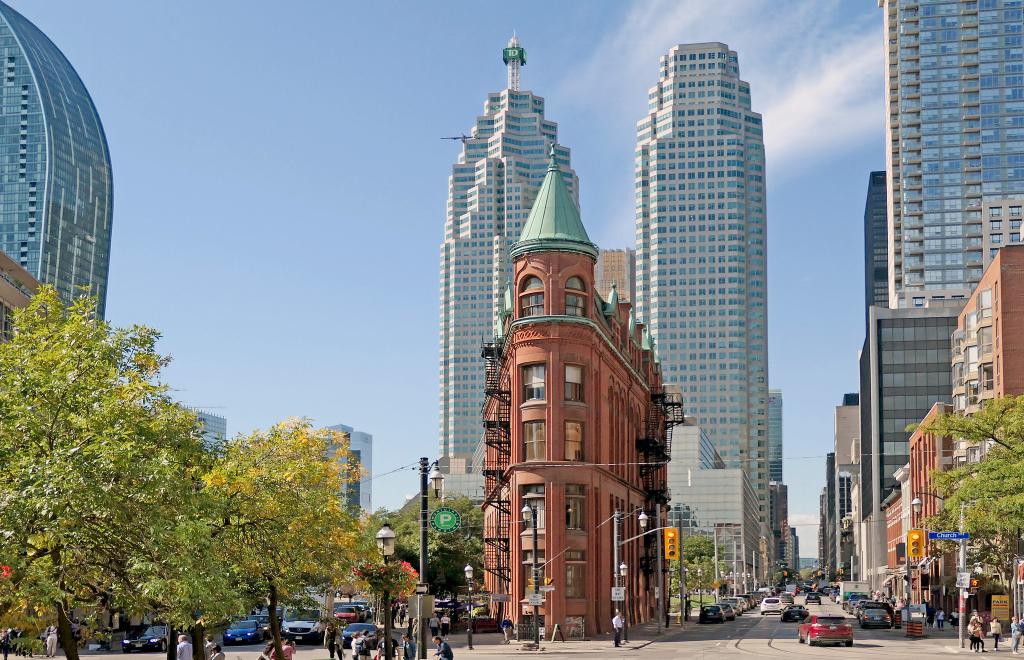Where Is Gooderham Building Location: Map and Helpful Insights.: How Weather and Nearby Attractions Can Make It Memorable.}
Where Is Gooderham Building Location: Map and Helpful Insights.: How Weather and Nearby Attractions Can Make It Memorable.}
Blog Article
Discover the Rich History Behind the Gooderham Structure in Toronto
The Gooderham Structure, an excellent symptom of Richardsonian Romanesque style in Toronto, has a fabled past that prolongs past its striking red block façade. Appointed by the influential Gooderham and Worts distillery in 1891, this building has played a crucial role in shaping the city landscape of the St. Lawrence Market area.

Beginnings of the Gooderham Building
Creating an enduring legacy, the Gooderham Building, also recognized as the Flatiron Structure, became a sign of Toronto's architectural advancement in the late 19th century. The building's beginnings trace back to 1891 when it was appointed by the Gooderham and Worts distillery, one of copyright's biggest distilling companies. Developed by architect David Roberts Jr. Gooderham Building address., the structure was distinctly positioned at the junction of Front and Wellington Streets, making the most of a triangular whole lot created by the merging of these thoroughfares
The building's building and construction used neighborhood red block and terracotta, establishing a distinct visual that enhanced the blossoming cityscape. Initially planned to house the Gooderham and Worts offices, the building stood for the success of the distillery, which had actually become a substantial contributor to Toronto's economic situation. Especially, the conclusion of the Gooderham Building corresponded with a duration of rapid urbanization that identified the era.
The facility of this building gem not just showcased ingenious layout yet additionally prepared for future advancements in Toronto. Today, it stands as a testament to the city's abundant history and flexibility, proceeding to bring in site visitors and admirers from around the world.
Architectural Value
The building importance of the Gooderham Building prolongs past its distinctive flatiron shape, showing the cutting-edge spirit of late 19th-century layout. Completed in 1892, the structure exemplifies the Richardsonian Romanesque style, characterized by its robust masonry, rounded arches, and complex outlining. The strong usage of different products, especially the cozy red block and sedimentary rock accents, improves its aesthetic charm and demonstrates the craftsmanship of the age.
The building's three-story design is significant for its unified proportions and elegant cornice, which add to its iconic silhouette against the Toronto skyline. The slim lot on which it stands posed unique challenges, yet the architects, in this instance, made a framework that optimized the offered area while keeping visual balance.
Additionally, the Gooderham Building is a testimony to the flexibility of architectural layout in metropolitan environments. Its long-lasting visibility in the middle of modern developments highlights the value of preserving historical style as a way of honoring a city's past. Today, it remains a precious landmark, showing both the architectural patterns of its time and the developing story of Toronto as a lively urban facility.
Function in Toronto's Growth
Becoming a principal in Toronto's city landscape, the Gooderham Building added substantially to the city's development throughout the late 19th century. Created in 1892, this famous building stood for not only the building ambitions of the moment but also the blossoming financial landscape of Toronto. The building was at first created to function as a warehouse for the Gooderham and Worts distillery, which was among the biggest distilleries in the British Realm. Its calculated location at the crossway of Front and Wellington Streets assisted in the movement of products and solutions, emphasizing the location's relevance in the city's commercial activities.
As the city increased, the Gooderham Building became a vital component of the St. Lawrence Market location, which was a center of profession and commerce. In essence, the Gooderham Structure is not simply an architectural landmark; it played a pivotal duty in shaping Toronto's identity and economic development throughout a transformative period in its history.
Social Effect and Legacy
Gooderham Structure's distinctive architectural design and historical significance have actually left an indelible mark on Toronto's social landscape. As one of the city's most identifiable sites, its one-of-a-kind flatiron form and complex brickwork exemplify the Victorian architectural patterns of the late 19th century. This structure not only works as a visual support in the St. Lawrence community yet likewise personifies the spirit of a burgeoning city during an era of financial growth.
The structure has come to be a sign of Toronto's rich background, inspiring neighborhood musicians and professional photographers who look for to capture its beauty. Its existence has actually promoted a feeling of community identification, adding to the story of metropolitan development. In addition, the Gooderham Building has actually played a critical duty in the tourism sector, drawing in visitors eager to discover its fabled past and architectural elegance.
In addition to its aesthetic appeal, the structure envelops a narrative of durability and adjustment, as it has transitioned via various usages over the decades - Gooderham Building address. Therefore, the Gooderham Structure stands not only as a monument of building significance however also as a testament to the advancing cultural heritage of Toronto

Remediation and Preservation Initiatives
Numerous repair and preservation efforts have actually been embarked on to guarantee the Gooderham Structure stays an important part of Toronto's building heritage. Originally finished in 1892, the structure has actually gone through considerable restorations to attend to architectural issues while maintaining its historic integrity. The most notable repair occurred in the late 20th century when the building was thoroughly reconditioned to meet Visit Website contemporary safety criteria without compromising its initial layout components.
These initiatives included fixing the distinctive red-brick frontage, restoring the legendary triangular shape, and maintaining the complex masonry details. Furthermore, the structure's interior has seen careful updates that value its historic significance, making sure that original functions such as wood light beams and ornamental moldings are kept.
The Gooderham Building is now shielded as a designated heritage building under the Ontario Heritage Act, which helps secure it from unsuitable alterations. Neighborhood involvement has actually played an essential function in these conservation initiatives, with local advocacy groups elevating awareness concerning the structure's historic importance. As a result, the Gooderham Building stands not only as a functional space but likewise as a testimony to Toronto's abundant building background and withstanding cultural legacy.
Conclusion

Please visit one of our local supporters - Https://therepairstore.ca/iphone-repair/
Report this page